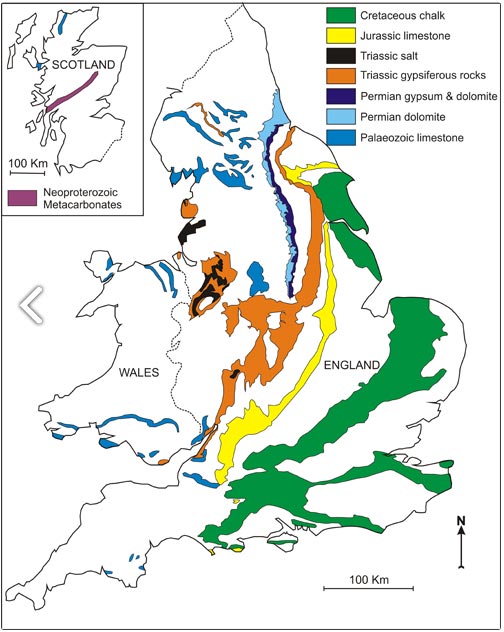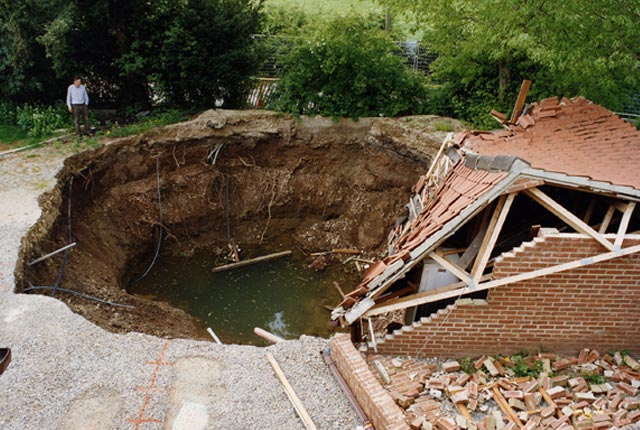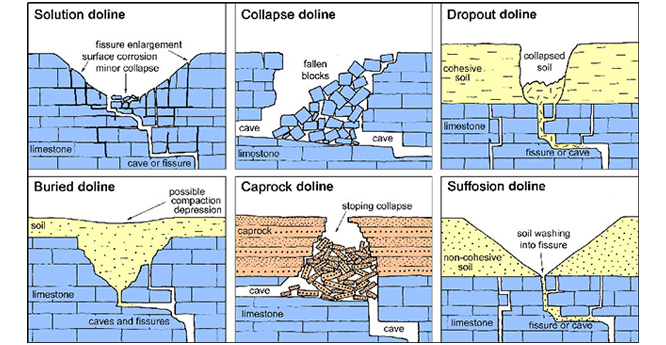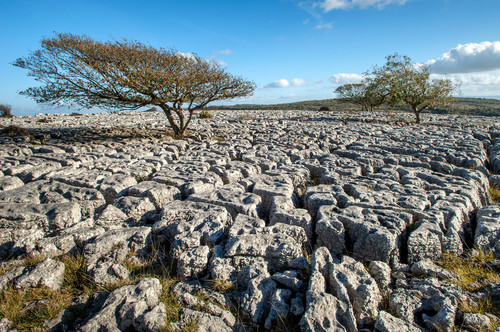There are several different types of sinkhole (also known as dolines) caused by different processes, including dissolution, collapse and erosion.
Dissolution
Some sinkholes result from the surface dissolution of soluble rock. For example, limestone rocks dissolve when attacked by rainfall or groundwater that is acidic.

Soluble rocks in the UK. BGS © UKRI.
Collapse
Collapse dolines occur as consequence of the gradual collapse of a cave passage at depth. The collapse may gradually propagate up through the overlying strata to cause subsidence at the surface (a ‘collapse sinkhole’). These sometimes extend up into rocks that are not themselves prone to dissolution, creating a ‘caprock sinkhole’. Sinkholes of this type are common in parts of South Wales where sandstone rocks overlie cavernous limestone and in Ripon, Yorkshire, where sandstone and limestone overlie gypsum. Others may be buried by more recent deposits.

Collapse of four garages into subsidence hollow caused by the dissolution of gypsum at Ripon, North Yorkshire, 1997. BGS © UKRI.
Dissolution and collapse
Sinkholes can also form as a result of both dissolution and subsequent collapse. Where a thin covering of loose, superficial material (such as sand, clay or soil) covers the soluble rocks beneath, the soil can be washed into solutionally widened fissures or cavities below. If the cover material is sandy, it will tend to gradually slump into the fissures, slowly creating a sinkhole over time (suffosion sinkhole). However, if the material is more cohesive, like clay, then the cavity can grow quite large before suddenly collapsing; a process termed a ‘drop out’ sinkhole. It is these more spectacular collapses (dropout) that sometimes hit the headlines, for example in the area of Ripon.

Erosion
Some sinkholes are caused not by dissolution of limestone, but the erosion of weak, unconsolidated material by flowing water. Loose material can removed by a process called ‘soil piping’, creating large voids within the sediment. One of the most spectacular examples of this type of collapse is the event that occurred in May 2010 in Guatemala City. Here, cavities developed in weak, unconsolidated, volcanic deposits following a tropical storm. These then collapsed, creating a shaft approximately 100 m deep and 20 m wide.
Areas prone to sinkhole formation occur throughout the UK, although most are relatively small or are in upland rural locations. They include areas underlain by Carboniferous limestones, notably the Mendips, parts of Wales, the Peak District, and the northern Pennines including the Yorkshire Dales.
The Chalk Group is also susceptible, especially where it is covered by younger clay and sand deposits (such as the Clay-with-Flints Formation and other Palaeogene strata), notably in parts of Dorset, Hampshire and the Chilterns.
The most susceptible area in the UK is the Permian gypsum in north-east England, particularly around Ripon and areas underlain by a similar geology. In Ripon, many large sinkholes have developed, some of which have affected property and infrastructure. This is because gypsum is far more soluble than limestone and dissolves more rapidly.
Sinkholes also occur over salt deposits, commonly in areas such as Cheshire where brine has been extracted, making it difficult to separate naturally formed sinkholes from those created artificially.
In Scotland, sinkholes are generally rare except in parts of Assynt that are underlain by limestones of the Cambrian Durness Group.
Several things can trigger sinkholes. Whilst the process of gradual dissolution can cause a sinkhole to form at the surface, other factors, including humans, can induce sinkholes to form.
- Heavy rain or surface flooding can initiate the collapse of normally stable cavities, especially those developed within superficial deposits.
- Leaking drainage pipes, burst water mains, irrigation or even the act of emptying a swimming pool are all documented examples of sinkhole triggers.
- Construction and development modifying surface drainage or altering the loads imposed on the ground without adequate support can cause sinkholes to develop.
- Groundwater abstraction can cause sinkholes by changing the level of the water table. This removes the buoyant support water provides to a cavity. Draining these cavities can cause them to collapse.
- Mining can be a factor in causing sinkholes, either by dewatering and lowering of the water table or by intercepting clay-filled voids, which subsequently collapse. Several sinkholes in Norwich have been caused by old chalk mines intercepting otherwise stable, sediment-filled voids.
Sinkholes form as a consequence of the recharge, through-flow and discharge hydrology of hydrogeological systems associated with soluble rocks and lead to karst (landscapes that result from the dissolution of soluble rocks). Our researchers are interested in a number of aspects of karst, including karst processes, dating, landscape evolution, geoconservation and the implications for applied geology, including groundwater resources and engineering geology.
Sinkholes can occur rapidly and apparently without warning. It is therefore important to:
- consider the potential for sinkholes during planning (hazard susceptibility studies)
- characterise them, so that people can mitigate with a reliable understanding of the likely 3D shape and size
- provide information for emergency response
The hazards associated with sinkholes can be mitigated by:
- appropriate planning
- good site investigation (with geophysics and boreholes)
- appropriate design
- proper maintenance of infrastructure, such as drains and services
Care is required when installing any structures that could affect the local groundwater flow or groundwater levels, including soakaways (sustainable drainage systems or SuDs) and open-loop ground-source heat pumps. In some places, these may be impractical in soluble rocks.
Further information
The BGS provides information regarding the susceptibility of the ground to dissolution and mining. This does not include information on the associated likelihood. The likelihood of occurrence is also linked to the history of the development of a site; for example, many sites will have been remediated. Additionally, the distribution of medieval workings is poorly documented and the available information on mines is limited.
If you wish to know whether your area is prone to sinkholes, you can find out by using BGS GeoSure data to access information on these geological hazards. The methodology behind the development of the BGS GeoSure dissolution hazard layer is outlined in Karst geohazards in the UK: the use of digital data for hazard management.
You may also be interested in

Sinkholes and karst research
Our research extends beyond the distribution and processes associated with sinkhole formation to the broader subject of karst.



